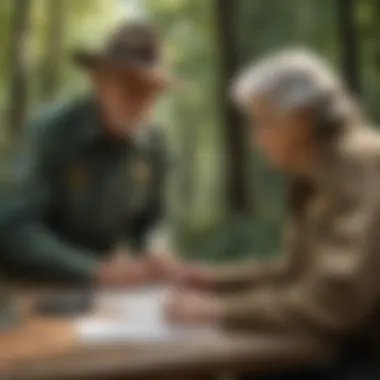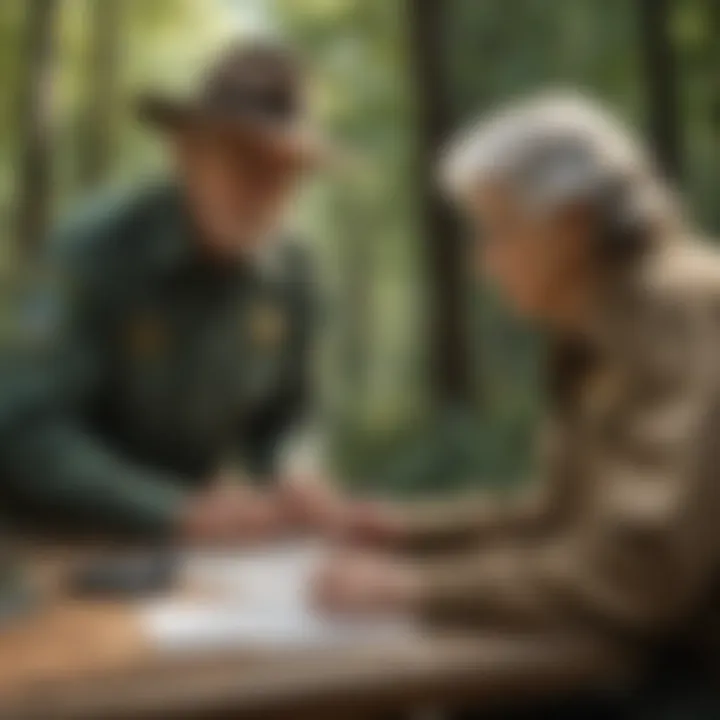Maximizing State Park Senior Discounts for Nature Lovers


Intro
State parks, with their sprawling landscapes and untouched nature, hold a special allure for many, particularly seniors. With age comes an appreciation for the subtler aspects of the great outdoors – the whisper of trees swaying in the wind, the rustle of leaves underfoot, and the vibrant colors of a sunset reflecting on a tranquil lake. However, enjoying these experiences doesn't always come without a cost. Thankfully, many state parks across America offer discounts specifically catered to senior visitors, making it easier for them to immerse themselves in nature without breaking the bank.
This article serves as a thorough guide to navigating the intricacies of state park senior discounts. From understanding eligibility requirements to discovering local options, and even delving into strategies for responsible enjoyment of the outdoors, this resource aims to equip seniors with the tools needed to make the most of their nature experience.
We'll examine the history behind these discounts, exploring why they were initiated and how they play a role in increasing park visitation. Moreover, we will take a closer look at outreach initiatives aimed at informing seniors about these beneficial programs. In doing so, we’ll highlight state-specific offerings and touch upon the critical balance between increasing access for the elderly demographic and preserving the very environments they wish to explore.
Throughout this narrative, the importance of ecological awareness will remain a central theme, emphasizing that while the beauty of American parks is a treasure to be enjoyed, it also deserves to be protected for future generations. Let's embark on this journey together and uncover the vast opportunities awaiting seniors in America’s state parks.
Preamble to State Park Senior Discounts
State parks serve as a vibrant tapestry of natural splendor, historical significance, and community gathering. Among the multitude of visitors who flock to these outdoor sanctuaries, seniors represent a unique and passionate demographic, deeply in touch with both the beauty of nature and the benefits of spending time outdoors. As such, state park senior discounts emerge as an essential component of making these experiences more accessible.
These discounts are not merely a financial incentive; they often reflect a deeper understanding of the needs and contributions of older adults in society. By offering reduced fees or special passes, state parks are encouraging seniors to engage with their natural surroundings. This support promotes not just individual enjoyment, but fosters a collective appreciation for conservation and sustainable tourism.
Defining Senior Discounts
Senior discounts in state parks can encompass a variety of offerings, including daily entry fees, camping charges, and even guided tour costs. Generally, any individual aged 62 or older may qualify for these discounts, although specifics can differ by state and park. Some parks adopt a flat fee reduction, while others might implement a percentage-based discount system. Understanding the precise terms and conditions is vital for seniors aiming to maximize their savings.
It’s crucial to note that while many parks extend these discounts, not all locations are created equal. Some might surprise you with generous deals, while others may have stricter guidelines. Thus, familiarity with the particular offerings of each park can enable seniors to plan accordingly and optimize their visits.
Purpose and Importance
The rationale behind state park senior discounts stretches beyond just numbers. They serve as an invitation to seniors to discover, explore, and appreciate the great outdoors. The benefits of outdoor activity for seniors are well-documented, ranging from physical health improvements to significant boosts in mental well-being. As participants in the natural world, older adults reap the advantages of fresh air, exercise, and community interaction.
Moreover, these discounts positively influence local economies. Increased visitation rates to state parks lead to higher spending in surrounding communities, supporting local businesses and fostering a sense of economic vitality. Parks not only provide a venue for leisure but also act as cornerstones for regional economic health.
"By encouraging older adults to engage with their natural surroundings, state parks become places where interactions blossom, memories are created, and local economies thrive."
In summary, the essence of state park senior discounts encapsulates both accessibility and appreciation—bridging the gap between generations and allowing seniors the chance to enrich their lives through nature. Understanding these discounts is the gateway to immersing oneself in the wonder of America's state parks, making it imperative for seniors to grasp their options and benefits.
Eligibility Requirements for Seniors
Navigating the world of state park senior discounts involves understanding a few key eligibility requirements. This section is pivotal for seniors looking to enjoy nature within a framework of affordability. Knowing what qualifies one for these discounts not only sets expectations but also opens up a wealth of opportunities for engagement with the outdoors. Different states may have distinct criteria, but the fundamental aspects tend to share common threads, enriching the overall experience for seniors.
Age Criteria
Age is the primary determinant when it comes to qualifying for senior discounts in most state parks. Typically, individuals aged 62 years and above are deemed eligible. This age threshold resonates with social paradigms of retirement and leisure, making it a common practice across various parks. Some states, however, have nuances in their criteria. For instance, in California, one can secure discounts at a mere age of 60, encouraging earlier access to natural settings for those in their silver years. It’s worth noting that these age limits serve a dual purpose: they extend gratitude to older generations while also promoting social inclusion in outdoor activities.
Identification and Documentation
Having the right identification is essential for seniors wishing to take advantage of these discounts. Generally, a government-issued ID such as a driver's license or passport, which clearly indicates the applicant’s age, will suffice. Some parks may also require proof of residency, especially when discounts are offered exclusively to state residents.
The documentation process can vary, but many parks are progressively introducing digital methods for verification, thereby streamlining the way seniors can access their benefits. Here are a few considerations for seniors to keep in mind regarding identification:
- Keep a copy of your ID handy when visiting a state park.
- Check if the park has any specific requirements for proof of residency or additional documentation.
- Stay informed about any changes in identification policies, as these may evolve over time.
Ultimately, knowing both the age requirements and necessary documentation fosters a seamless engagement with the beauty that state parks offer. Understanding these criteria helps not simply in maximizing discounts but also enhances the enjoyment of what nature has to offer.
State-Specific Discounts Overview
Understanding the state-specific discounts available to seniors is essential for maximizing their nature experiences. Each state in the U.S. provides varied programs tailored for senior citizens, reflecting local priorities, funding availability, and regional attractions. These discounts not only encourage engagement with the great outdoors but also support local economies by driving traffic into parks and recreational areas. In this section, we will explore the specifics from California, Texas, and Florida, detailing the nuances of each state's offerings and how they align with the needs of senior visitors.
California
California, known for its stunning landscapes ranging from the coastal cliffs of Big Sur to the towering sequoias of Sequoia National Park, offers an array of senior discounts designed to make these natural wonders more accessible.
Seniors aged 62 and older can enjoy a half-price discount on the California State Parks annual pass, which provides entry to over 280 state parks. This significant reduction encourages older adults to explore state treasures, enriching their lives with the healing benefits of nature.
Additionally, certain parks, like Yosemite, offer complimentary entry on designated days, such as National Parks Day. Seniors can take advantage of such promotions to experience the awe-inspiring scenery without the financial burden.
A particular consideration in California is the seasonal nature of park activities.
- Spring brings wildflower blooms.
- Summer is perfect for hiking.
- Fall offers vivid foliage.
- Winter presents unique opportunities for snow sports in the Sierra Nevada.
These variations enable seniors to plan visits that cater to their interests and physical ability.
Texas


In Texas, state parks span vast landscapes, from the deserts of Big Bend to the lush piney woods in the east. The state recognizes the contributions seniors make to their communities and aims to support their outdoor adventures through discounts.
Seniors can benefit from a Lifetime Senior Pass for a one-time fee, granting them access to all Texas State Parks. This affordability encourages repeated visits, fostering an appreciation for nature while also promoting it within the community. Furthermore, during off-peak seasons, many parks run promotions that lower fees for senior visitors.
Key attractions like Guadalupe Mountains National Park and Palo Duro Canyon State Park host special events and educational programs tailored for older adults, such as workshops on local flora and fauna, which enhance their experience and knowledge of the environment.
Florida
Florida's state parks, with their extraordinary biodiversity and inviting climate, are prime spots for seniors seeking outdoor enjoyment. The state offers a Florida State Parks Senior Citizen Pass that allows seniors over 65 to enter any state park for free, a significant boon for older visitors looking to appreciate the sunshine and fresh air.
Moreover, many parks provide guided nature walks and interpretive programs aimed specifically at senior participants. This hands-on approach allows seniors not only to explore but to learn and connect with others who share their love for nature. Parks like Everglades National Park and Biscayne National Park offer unique experiences that encourage interactions, ensuring seniors can enjoy everything from trekking through swamps to kayaking along serene waters.
Accessibility is also a focal point in Florida, with ample amenities like paved paths and wheelchair rentals available in many parks.
Economic Impact of Senior Discounts
When discussing senior discounts in state parks, one cannot overlook the significant economic ramifications that come into play. These discounts not only enhance access to majestic landscapes for older citizens, but they also cultivate a ripple effect that extends to local economies. By understanding this interconnectedness, we can appreciate how these discounts serve a dual purpose: they promote community engagement while also ensuring the sustenance of our natural environments.
Increased Access to Parks
One of the most immediate effects of offering discounts to seniors is the marked increase in park visitation. Many older adults, particularly on fixed incomes, find that the financial relief provided by discounts is the difference between visiting a park or staying home. These discounts have an outsized impact on attendance figures, as parks become more accessible to a demographic that may otherwise be hesitant to engage with nature due to costs.
For example, a national park like Yellowstone may offer discounts of up to 50%, encouraging more seniors to experience its geological wonders. When parks implement such policies, a notable influx of seniors can be observed, enjoying not only the beauty of the landscapes but also the social interactions that come with this communal experience.
Moreover, increased foot traffic in parks often leads to greater usage of amenities, which might include visitor centers, concession stands, and rental services, thereby boosting operational revenue that can support the maintenance and development of the park itself.
Boosting Local Economies
The advantages of increased park access don't stop at just the numbers. They have tangible benefits for local businesses as well. When seniors visit state parks, many often spend money in surrounding towns—shopping for essentials, dining at local restaurants, or staying overnight at nearby inns. This spending behavior can be crucial for small, family-owned establishments that thrive on seasonal tourism.
Studies suggest that for every dollar spent in state parks, up to $4 can be contributed to local economies. Here’s how it breaks down:
- Accommodation Services: Many seniors prefer to stay nearby rather than making a long drive back home after a day in nature.
- Food and Dining: Local eateries often see a spike in business from park visitors. Seniors tend to favor cozy diners where they can enjoy a good meal after hiking.
- Retail Shopping: Unique shops selling local crafts, souvenirs, and various services benefit from the foot traffic generated by visiting seniors.
"Senior discounts are a bridge, connecting nature enthusiasts to parks they might otherwise overlook due to financial constraints, but they also act as a lifeline for the local economy, invigorating businesses and supporting community livelihoods."
By facilitating access through discounts, state parks not only uphold their commitment to accessibility and inclusion but also catalyze economic activity—creating a bond between nature and local communities that bolsters both human and environmental vitality.
Outreach and Awareness Programs
Outreach and awareness programs serve as the bridge connecting seniors to the tranquil embrace of state parks. These initiatives not only inform seniors about the available discounts but also foster an understanding of the parks' ecological value. When implemented effectively, such programs can significantly enhance participation and engagement among elder visitors, allowing them to experience nature's beauty while also contributing to community health and sustainability.
Community Engagement Initiatives
Community engagement initiatives are crucial in creating a sense of belonging and connection. For instance, local parks might conduct workshops that allow seniors to gather in groups and explore the fundamentals of park resources, ranging from guided nature walks to photography classes. These sessions promote interaction and networking, which can often lead to longstanding friendships that enrich visitors’ experiences.
Benefits of Engagement Initiatives:
- Social Connections: Building bonds with fellow seniors fosters a supportive network, combatting loneliness often felt by this demographic.
- Increased Awareness: Initiatives also inform seniors about the health benefits of being active in nature, from physical vitality to mental clarity, ensuring they understand the profound impact parks can have on their overall well-being.
- Advocacy and Participation: Engaged communities are more likely to advocate for the preservation of natural spaces, ensuring parks remain accessible for future generations.
These grassroots movements not only empower seniors but also contribute to a thriving community that appreciates and utilizes local parks fully.
Educational Resources for Seniors
Understanding the myriad options available can be daunting for many seniors. Therefore, educational resources tailored specifically for them are essential. These range from pamphlets handed out at community centers to online webinars that outline the benefits of the discounts, available parks, and essential preparation tips for park excursions.
Key Components of Educational Resources:
- Workshops and Seminars: Monthly gatherings can foster an environment where seniors learn from park rangers and other experts about how to best enjoy their visits.
- Online Content: Websites often host blogs, FAQs, and e-brochures that provide seniors with valuable information about park facilities, nature trails, and senior-specific events.
- Local Partnerships: Collaborations with healthcare organizations can create programs focused on the health advantages of outdoor activities, often highlighting discounts available to seniors in local state parks.
Educational resources not only help in spreading awareness but also instill confidence in seniors as they navigate their park experiences, ensuring their trips are both fulfilling and enriching.
In summary, effective outreach and awareness programs tailored for seniors can transform state park visits into enriching experiences. By bridging the gap through community engagement and dedicated educational resources, parks can become welcoming havens for older adults, enhancing the relationship between them and the natural landscape.
Challenges in Implementing Discounts
The topic of challenges in implementing state park senior discounts holds significant weight in understanding the broader dynamics of park accessibility, funding, and administrative processes. While these discounts are designed to facilitate access for seniors, various obstacles can hinder their successful implementation. Recognizing and addressing these challenges not only enhances the sustainability of such programs but also preserves the overall integrity of nature exploration for older individuals.
Funding Limitations
When discussing funding limitations, it’s crucial to acknowledge the often tight budgets that state parks operate under. Many parks rely heavily on state and federal funding, which can fluctuate based on economic conditions and political priorities. As a result, discounts aimed at seniors may not always receive the financial backing necessary for robust implementation.


- State Budgets: State budgets naturally vary year over year. When revenues drop, parks with limited fiscal flexibility may resort to cutting programs.
- Priority Allocation: Parks may prioritize maintenance or enhancements over discount programs. In essence, funding often goes toward keeping existing facilities operational rather than promoting new initiatives.
- Dependence on Donations: The reliance on donations can also be a double-edged sword; while they can provide critical support, they are often unpredictable.
The implications of inadequate funding can lead to a scenario where discounts may be less effective or even temporary, resulting in a lack of visibility and outreach to potential users. As seen in some states, like Nevada and Kansas, when financial resources are constrained, outreach programs that inform senior citizens about available discounts are also impacted.
"Budget constraints often translate into diminished opportunities for community engagement, rendering some initiatives short-lived."
Administrative Burdens
Administrative burdens loom large as yet another significant hurdle in the execution of senior discount programs. The administrative side requires careful orchestration to ensure that both the park staff and the visitors comprehend the nuances of the discounts offered.
- Training Requirements: Staff members must be educated on the specific rules governing the discounts. Without sufficient training, misconceptions can arise, leading to frustration for seniors trying to understand eligibility criteria.
- Application Process: The complexity of the application process—if applicable—can deter senior citizens from applying. Simplicity in these procedures is crucial; if they’re convoluted, fewer seniors will take advantage of the benefits they are entitled to.
- Data Management: Parks must maintain accurate records and manage data related to discounts provided. Keeping a meticulous account can be resource-intensive, diverting staff attention from other important park activities.
Striking a balance between offering generous discounts and managing administrative responsibilities is no easy feat. Parks must tread lightly to maintain efficiency without alienating the very audience they aim to serve—those who seek to immerse themselves in nature.
Environmental Considerations
Exploring the offering of senior discounts at state parks opens up a compelling conversation about the environment. This aspect is not solely about saving a few bucks; it’s intertwined with the preservation of nature and conservation efforts that are crucial for sustainable park management. As seniors frequently visit these sites, the increased foot traffic generates both opportunities and challenges which need appropriate handling to ensure environmental sustainability.
Sustainable Park Management
Sustainable park management pertains to managing these natural resources in a way that maintains their integrity for future generations. It revolves around a balance: engaging visitors while protecting the ecosystems that make these parks valuable
- Resource Allocation: When state parks implement senior discounts, it can lead to higher visitation rates. This surge means that park management must allocate resources wisely. Facilities may need upgrades, trails could require maintenance, and conservationists must think ahead regarding wildlife management.
- Education and Awareness: With more visitors, especially seniors who often have more time to enjoy leisurely walks and observations, parks can educate about local flora and fauna. Guided tours and informational brochures tailored for seniors can create informed visitors who value conservation.
- Volunteer Programs: Many parks tap into the senior demographic's willingness to contribute. Volunteer programs not only aid in park maintenance but also empower seniors to foster a sense of ownership over the parks they enjoy. These engagements can lead to better conservation outcomes and a beneficial social interaction among peers.
"Sustainable management is about adapting practices that meet the needs of today's visitors while ensuring future generations can experience the same beauty."
Balancing Access with Conservation
Finding harmony between making parks accessible for all, particularly seniors, and conserving precious natural resources is no small feat.
- Visitor Impact Management: Park planners need to assess how senior populations utilize park spaces. Can paths accommodate mobility devices? Are there quiet zones to minimize disturbances to wildlife while enhancing visitor experience? Evaluating these factors ensures that while access is granted, the delicate balance of nature is not disrupted.
- Zoning Practices: Many parks employ zoning strategies that designate certain areas as high-use, while others are left more natural and undisturbed. This becomes increasingly vital as more seniors venture out into these sites. Planning visits around busy times can minimize wear on sensitive ecosystems and promote safer, more enjoyable experiences for older adults.
- Sustainability Messaging: Communication plays a pivotal role in addressing concerns regarding access versus conservation. Parks can provide materials that guide seniors on how to enjoy the outdoors responsibly. Simple reminders about sticking to trails or the importance of leaving no trace can make a significant difference.
Benefits of Visiting State Parks for Seniors
Visiting state parks offers a tapestry of advantages for seniors, weaving together threads of health, community, and personal fulfillment. Exploring these natural havens is not just a pastime but a way for older adults to engage with their surroundings and themselves. The multifaceted benefits stretch beyond leisure; they touch on physical well-being, mental health, and the sense of connection with nature and fellow park-goers.
Physical activity in natural settings promotes better health. Nature is a runway for movement, where the serene landscapes encourage seniors to walk, hike, or even engage in more robust exercises like kayaking. Consider the simple act of walking along a wooded path; this low-impact exercise can significantly benefit cardiovascular health, improve flexibility, and boost endurance. Regular physical activity lowers the risk of chronic diseases, enhances mobility, and improves balance, which becomes increasingly vital as we age.
On a broader scale, exposure to nature has been linked to lower mortality rates. A study from the University of East Anglia found that individuals who regularly spend time outdoors have a higher likelihood of longevity compared to those who do not. Given the sedentary lifestyle many seniors face, the encouragement to explore state parks adds a layer of proactive health management.
Physical Health Benefits
The physical advantages of visiting state parks shine a light on the importance seniors place on staying active, especially as joints and muscles become less forgiving. Some key Points to consider include:
- Increased Vitamin D Intake: Sunlight is a natural source of Vitamin D, essential for bone health. Seniors can benefit from spending time outdoors, absorbing this nutrient.
- Boosted Immunity: Nature walks and time spent outdoors can strengthen the immune system. Breathing in fresh air and enjoying natural scenery lowers stress, which in turn can help the body fend off illness.
- Posture and Core Strength: Walking on varied terrain, like hills or rocky paths, helps engage core muscles and improve posture.
"The park is not only a place to visit; it becomes a part of daily life, a natural prescription for an active body."
Mental and Emotional Well-Being
Mental clarity and emotional health often flourish in the great outdoors. The environment of state parks provides a sanctuary from the frenetic pace of urban life and technological distractions. Recognizing the significance of these places can lead to substantial improvements in mental wellness. Key components include:
- Stress Reduction: The mental clutter fades away amidst trees and lakes. Nature has a soothing effect on the human psyche, leading to lowered stress levels and anxiety.
- Cognitive Benefits: Nature walks have been associated with improved attention spans and cognitive functions, helping keep the mind sharp. This becomes especially beneficial for seniors, aiding in memory retention and focus.
- Social Interaction: Parks serve as meeting grounds for like-minded individuals. They foster friendships and community, thereby combating loneliness and isolation.
In summary, state parks hold a treasure trove of health benefits for seniors. They pave the way for improved physical health, bolster mental fortitude, and create a community fabric that supports engagement and connection. The importance of state parks—not only as destinations but as vibrant ecosystems for improved life quality—cannot be overstated.
Maximizing Your State Park Experience
Embracing the Great Outdoors
To truly appreciate the essence of state parks, seniors must go the extra mile in planning their visit. The blend of nature, history, and tranquility in these spaces can offer a refreshing escape from daily routines. This section delves into the practical aspects of maximizing enjoyment at state parks—from efficient planning to considering the best time of year to visit. Understanding these elements not only elevates one’s experience but also enriches the connection to the environment.
Planning Your Visit
Diligent planning lays the groundwork for a fulfilling park experience. Seniors should consider several factors before heading out:
- Research Park Attractions:
Take the time to explore what each state park offers. Attractions might include hiking trails, scenic lookouts, and picnic areas. For instance, while Yosemite National Park in California boasts breathtaking landscapes, the serenity of Big Bend National Park in Texas might appeal more to those seeking solitude. Knowing the highlights helps seniors to set priorities and maximize their visit. - Check Special Events:
Many parks organize events or guided tours specifically for seniors. These gatherings provide both opportunities for social interaction and added knowledge about the park’s ecosystem and history. Consider looking up local event calendars beforehand to catch something unique. - Accessibility Options:
Not all parks are created equal when it comes to accessibility. Seniors with mobility concerns should explore areas that offer wheelchair rentals or well-maintained paths. Checking park websites can provide insights into accessible amenities and services available. - Pack Smart:
Packing the right essentials can make or break a park visit. Comfortable shoes, weather-appropriate clothing, snacks, and a refillable water bottle are a must. Also, don't forget any necessary medication or first-aid items, as enjoying nature should not come at the cost of personal safety.
Choosing the Right Season
Timing can significantly influence the park experience. Each season brings its own charm and set of activities:
- Spring Blossoms:
As nature awakens from winter slumber, spring provides vibrant blooms and mild weather. Parks such as the Great Smoky Mountains or the Blue Ridge Parkway offer beautiful displays of wildflowers and budding trees that can be enchanting. - Summer Adventures:
The summer months are bustling with activity; trails are well-maintained, making it ideal for longer hikes. However, bear in mind that this is peak tourist season, and parks may get crowded. Early morning or late afternoon visits can help avoid the hustle. - Autumn Colors:
Fall is perhaps one of the most visually stunning seasons, with foliage transforming into a collage of red, orange, and gold. Parks like Acadia in Maine and the Shenandoah Valley in Virginia showcase breathtaking views, providing perfect backdrops for photography aficionados. - Winter Retreats:
For those who enjoy the magical frost of winter, visiting parks like Yellowstone or Glacier National Park can provide peace and a unique perspective on nature's beauty. Snowshoeing and winter hiking can offer adventure with an added sense of tranquility away from the bustling summer crowds.


"Careful planning not only enriches the experience but makes each moment spent amidst nature invaluable for seniors."
Seniors have a wealth of experiences waiting to unfold within state parks. By focusing on meticulous planning and seasonal advantages, they can ensure that their visits are not just enjoyable but deeply memorable.
Personal Experiences and Testimonials
Understanding the real-world impact of state park senior discounts doesn't lie solely in statistics or charts. It thrives in the heartfelt stories and testimonials from senior visitors. These narratives provide a human touch, shedding light on how discounts can bridge the gap between isolation and community, bringing senior citizens closer to nature and each other. It's not just about the financial savings; it’s about fostering connections with the environment and other park-goers.
Stories from Senior Visitors
Many seniors have personal stories that illustrate the transformative power of these discounts. For example, Martha, a 72-year-old retired school teacher from Oregon, discovered a new passion for hiking through her local state park. Initially hesitant due to cost concerns, Martha found relief in the senior discount offered at Silver Falls State Park. Now, she spends her weekends meandering through vibrant trails and has even joined a walking group of other seniors.
Her account reflects a broader trend: discounts can lead to rekindled experiences.
- Shared Moments: Numerous visitors highlight that encounters with fellow park enthusiasts often blossom into friendships, creating a sense of community.
- Rediscovering Nature: Seniors often reminisce about their youth spent in nature. Parks encourage them to revisit those memories and create new ones, further enhancing their quality of life.
- Participation in Programs: Many state parks offer special programs for seniors. Helen, a 68-year-old from Florida, shared her experience at one such gathering where she learned about birdwatching. She enthused how this exposure not only fueled her interest but also allowed her to meet like-minded individuals, fostering social interactions that are crucial for mental wellness.
Such personal anecdotes underline the broader societal benefits of these discounts. They act as conduits through which seniors connect with their environment and community, enriching their lives significantly.
Impact on Community
The consequences of fostering a nature-oriented community through senior discounts extend deeply into local ecosystems and economies. When seniors engage with parks, they contribute to a more vibrant social fabric.
- Volunteer Opportunities: Park engagement often leads many seniors to volunteer, helping maintain trails or assist in educational programs. This participation not only benefits the park system but also creates a sense of purpose among older adults.
- Economic Benefits: When more seniors visit, local businesses such as nearby cafes, resorts, and shops can see significant gains. This influx supports local economies and encourages community development.
- Cultural Exchange: State parks often become melting pots where seniors from diverse backgrounds exchange stories and traditions, enriching the community's cultural heritage.
"When senior discounts lead to more visitors, it doesn't just benefit the parks, but it empowers local businesses and fosters an enriched social scene," says Leonard, a park ranger in Texas.
Thus, the personal stories of senior visitors not only highlight individual benefits but they also point to a larger narrative. This narrative involves the interplay between nature, personal enrichment, and community upliftment, all fueled by a simple initiative—affordable access.
Future Trends in State Park Senior Discounts
State parks have long embraced the idea of senior discounts, but looking ahead, the strategies and considerations surrounding these programs are evolving. It’s not just about offering a nominal fee reduction anymore; it’s about sustainability, inclusivity, and health benefits for an aging population. Understanding what’s on the horizon can inform better practices and broaden the positive impact of these initiatives.
Long-Term Sustainability Practices
With climate change becoming an unavoidable topic in conservation discussions, state parks are pivoting towards sustainable practices that benefit both ecosystems and visitors, particularly seniors. These practices include:
- Eco-Friendly Infrastructure: Many parks are investing in green infrastructure, such as solar-powered facilities and rain gardens. These not only reduce the environmental footprint but also promote a more enjoyable experience for visitors who appreciate nature.
- Habitat Restoration: Programs focusing on restoring native habitats often involve volunteer opportunities for seniors. This helps foster a sense of community and boosts physical activity, which is vital for maintaining health in older adults.
- Educational Programs: Engaging seniors through educational workshops about sustainability efforts can heighten awareness and empowerment. Imagine a park offering a guided walk that also discusses how to minimize one’s ecological impact while enjoying nature.
By incorporating these practices, state parks can ensure that they are not just a destination for today, but are also safeguarded for future generations, allowing seniors to enjoy nature's beauty for years to come.
Adapting to Aging Populations
Another significant trend is the shift to cater to the unique needs of an aging population. As the demographic landscape changes, it's crucial for state parks to consider:
- Accessibility Enhancements: This includes adding wheelchair-friendly trails and ensuring that facilities are easily navigable. For instance, Coral Pink Sand Dunes State Park in Utah has made strides in creating boardwalks that allow seniors to enjoy scenic views without struggling through uneven terrain.
- Health and Wellness Offerings: Programs designed around physical health can be highly beneficial. For instance, parks might introduce yoga classes in serene natural settings or guided nature walks that incorporate gentle exercises tailored for seniors.
- Technology Integration: Many seniors are becoming tech-savvy, which opens doors for mobile apps that aid navigation and highlight deals. Having an app tailored specifically for senior discounts could enhance accessibility and usability.
As we look towards the future, it’s clear that state parks can no longer afford to take a one-size-fits-all approach. By being responsive to the changing needs of seniors, parks can not only increase visitation but also foster an environment that encourages healthy lifestyles.
"In implementing sustainable practices and adapting to the needs of older visitors, state parks can enhance the quality of experiences while preserving the natural world for future generations."
By embracing both sustainability and the diverse needs of an aging population, state parks can continue to thrive, providing valuable experiences that go beyond simple discounts.
Epilogue: The Value of State Park Senior Discounts
The discussion surrounding state park senior discounts carries significant weight in recognizing and enhancing the overall value these discounts offer. They are not merely financial incentives; instead, they symbolize an invitation for seniors to reconnect with nature, fostering both personal well-being and environmental stewardship. Understanding this value requires a nuanced perspective, looking beyond immediate savings and delving into the broader implications for community and individual health.
Summarizing Key Points
The key points highlighted throughout this article showcase how state park senior discounts serve multiple purposes. Firstly, they provide financial relief to a demographic often on a fixed income, enabling easier access to the beauty of nature. By easing the financial burden, state parks see an influx of senior visitors, contributing to increased overall attendance and more vibrant park communities.
Moreover, specific eligibility requirements ensure that discounts are fairly distributed, while state-specific programs adapt to the needs of local populations. These tailored discounts are not solely about lowering prices; they reflect an understanding of the unique relationship seniors have with nature.
Another important point is the economic impact on local communities. When seniors visit parks, they not only enjoy the natural surroundings but also contribute to local economies through necessary expenditures on food, lodging, and other recreational activities. This symbiotic relationship can drive investments in infrastructure and park improvements, ultimately benefiting all visitors.
For a visual summary:
- Financial Benefit: Discounts help manage expenses.
- Community Engagement: Seniors participate, enhancing local economies.
- Environmental Connection: Encourages a sense of responsibility towards nature.
Encouraging Continued Engagement with Nature
Encouraging seniors to stay engaged with nature is essential not just for individual health, but also for cultivating a collective sense of responsibility towards the environment. Maintaining regular visits to state parks can lead to substantial physical health benefits by promoting an active lifestyle. Walking trails, birdwatching, or photography are just a few examples of how seniors can immerse themselves in nature, gaining both exercise and relaxation.
Furthermore, there lies a deeper emotional connection. Nature can serve as a sanctuary, promoting mindfulness and reducing stress among seniors. The challenge, however, is ensuring that these experiences are both enjoyable and accessible.
To this end, it is vital to promote programs that incorporate educational components – workshops that teach about local species or conservation methods can enrich visits. In fostering this relationship with nature, parks become not merely places to visit but spaces for teaching, learning, and personal growth.
In this way, the value of state parks extends well beyond discounts; it evolves into a movement that encourages well-rounded engagement and a commitment to conservation. Seniors have the potential to become remarkable stewards of our natural world, ensuring that both their own lives and the parks they cherish can thrive for generations to come.



